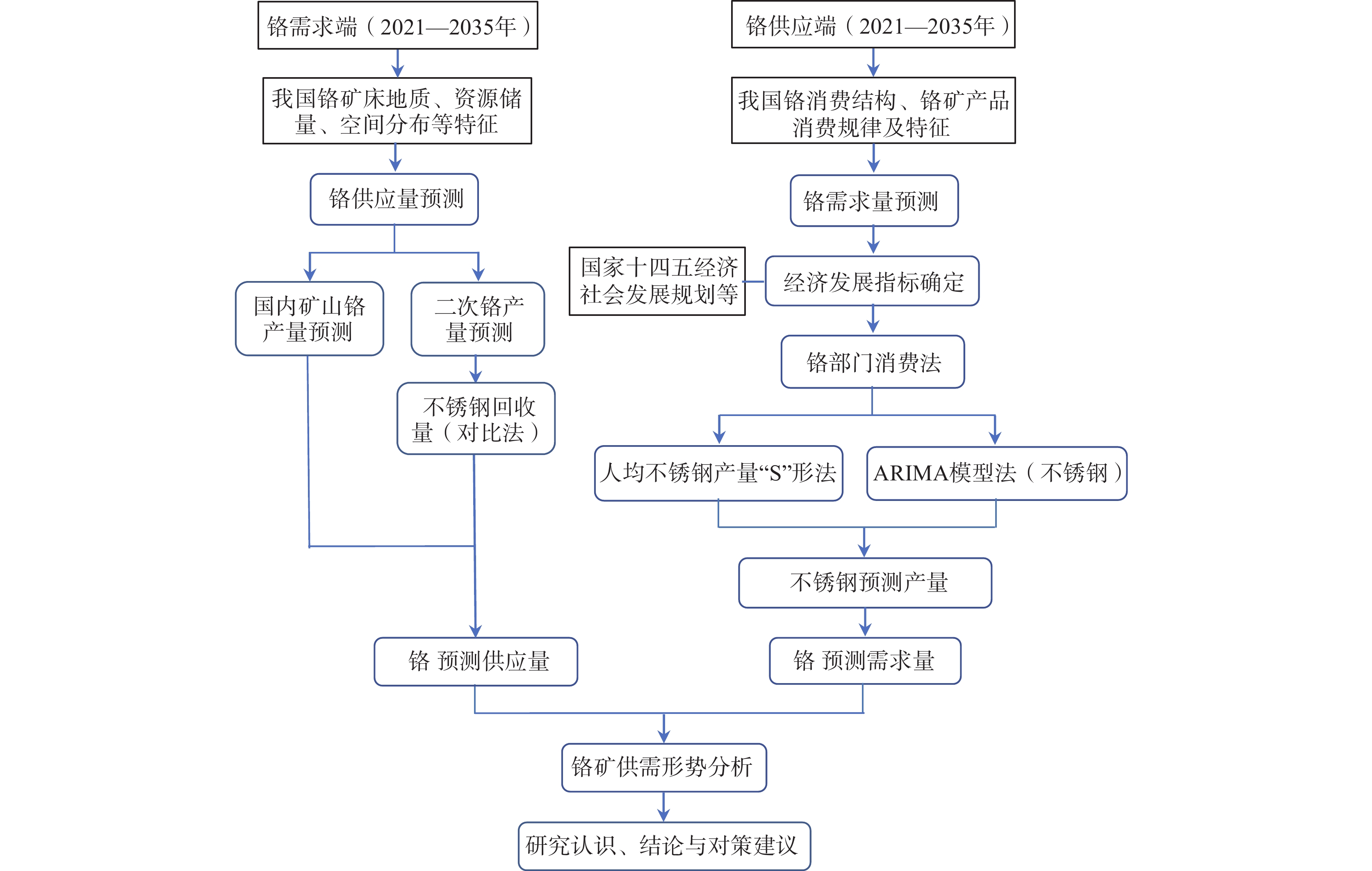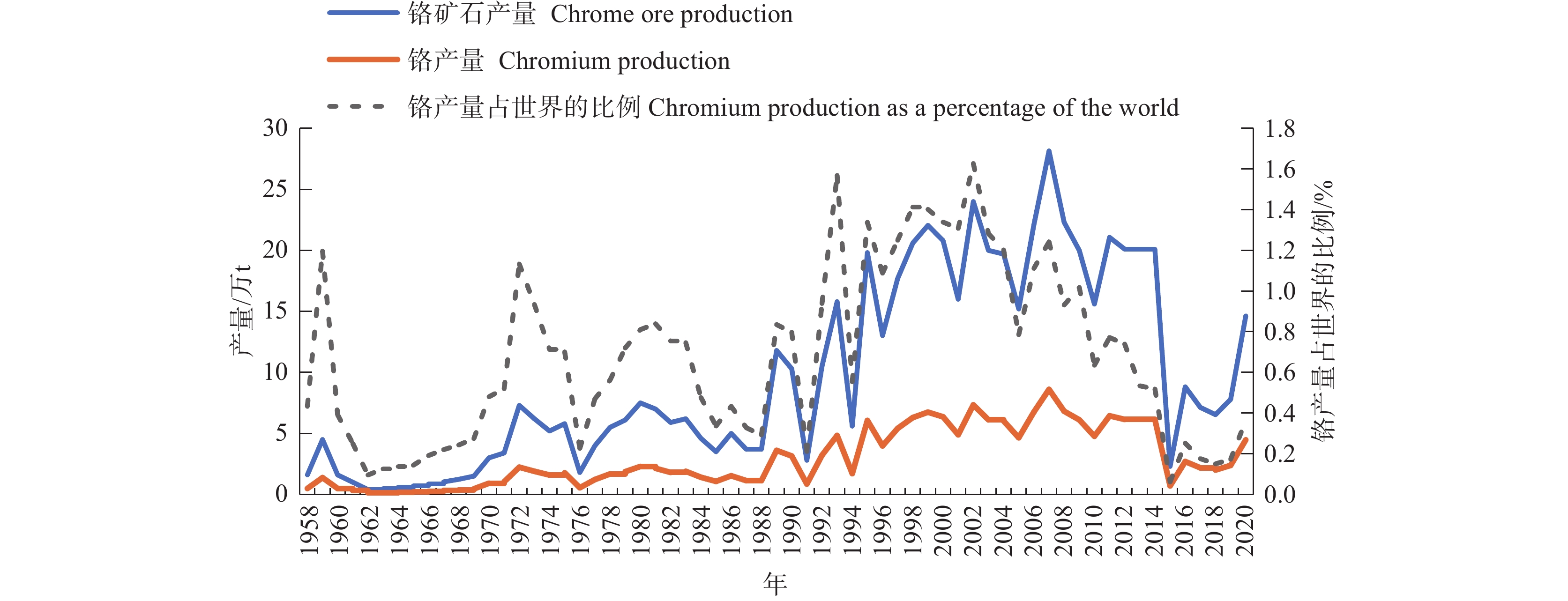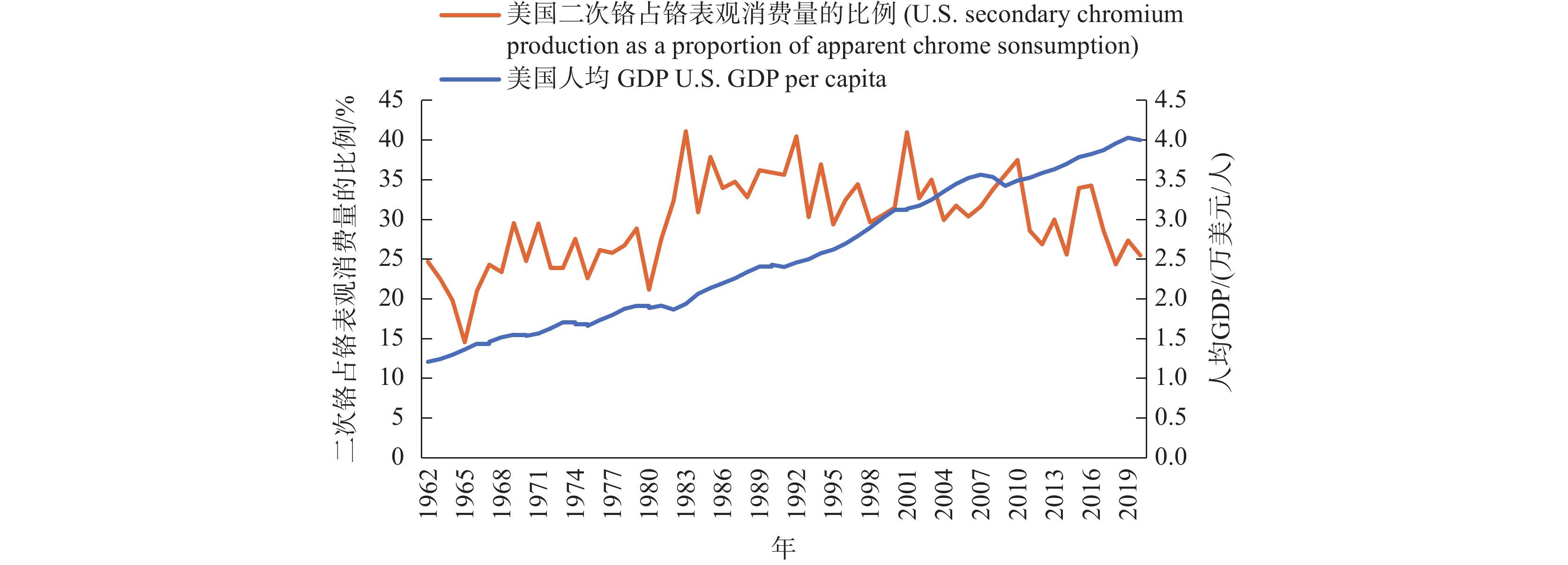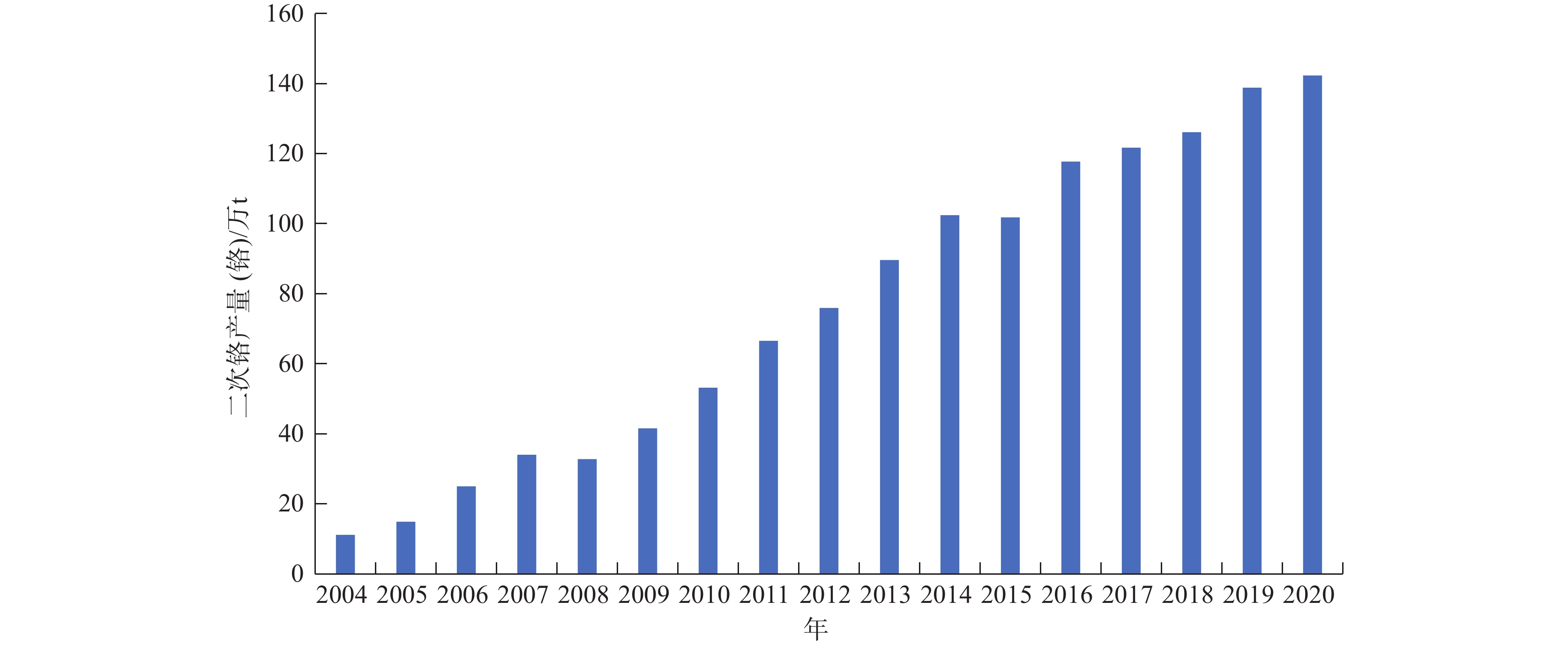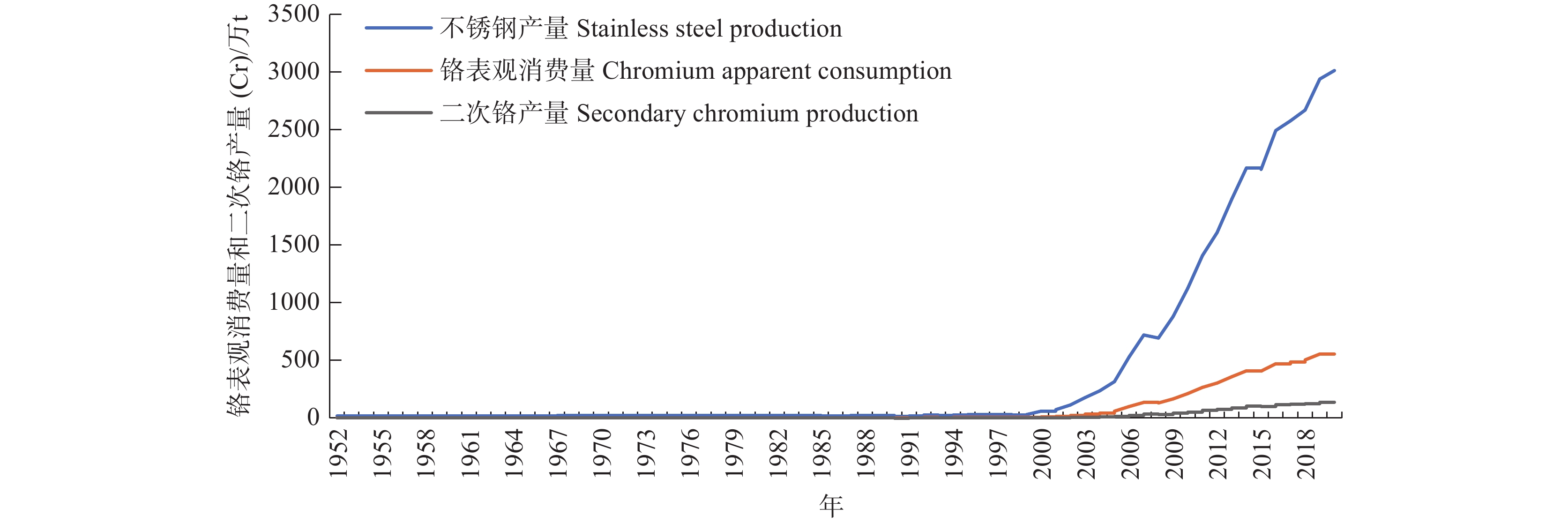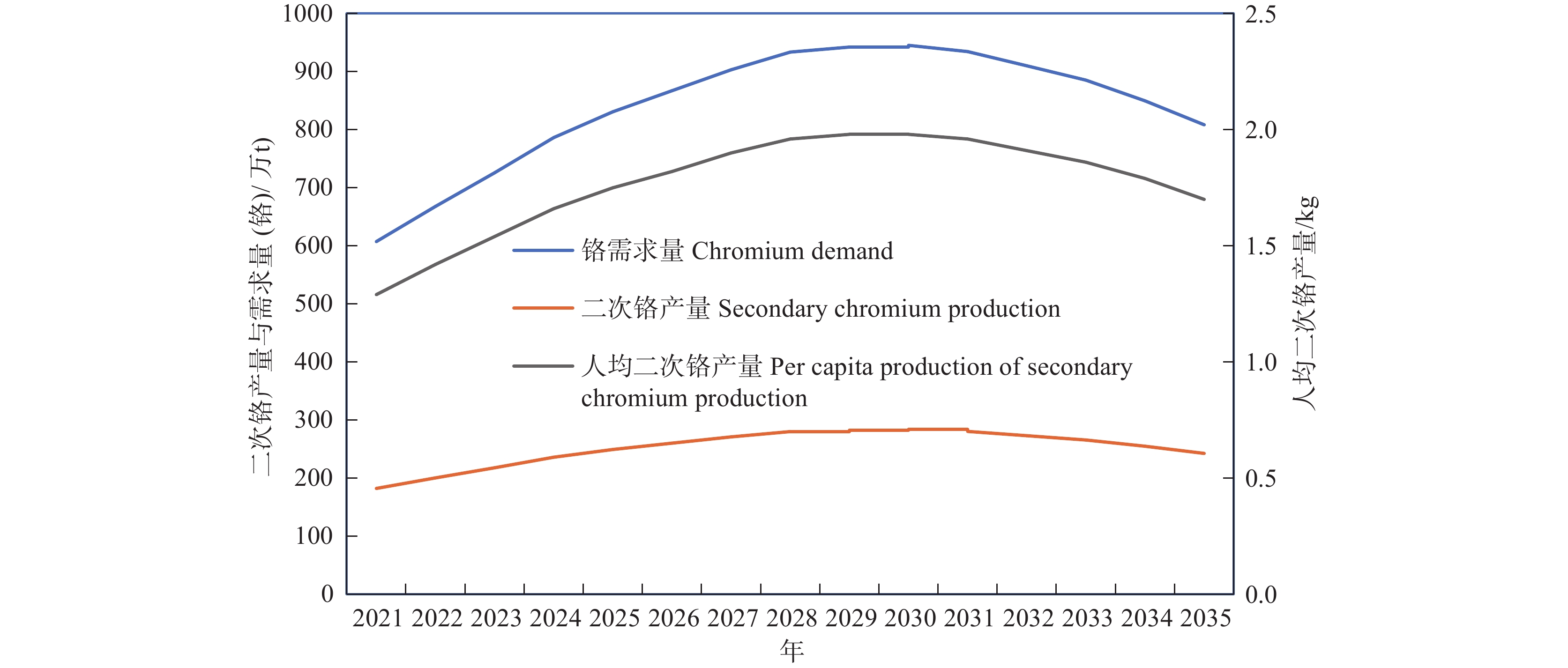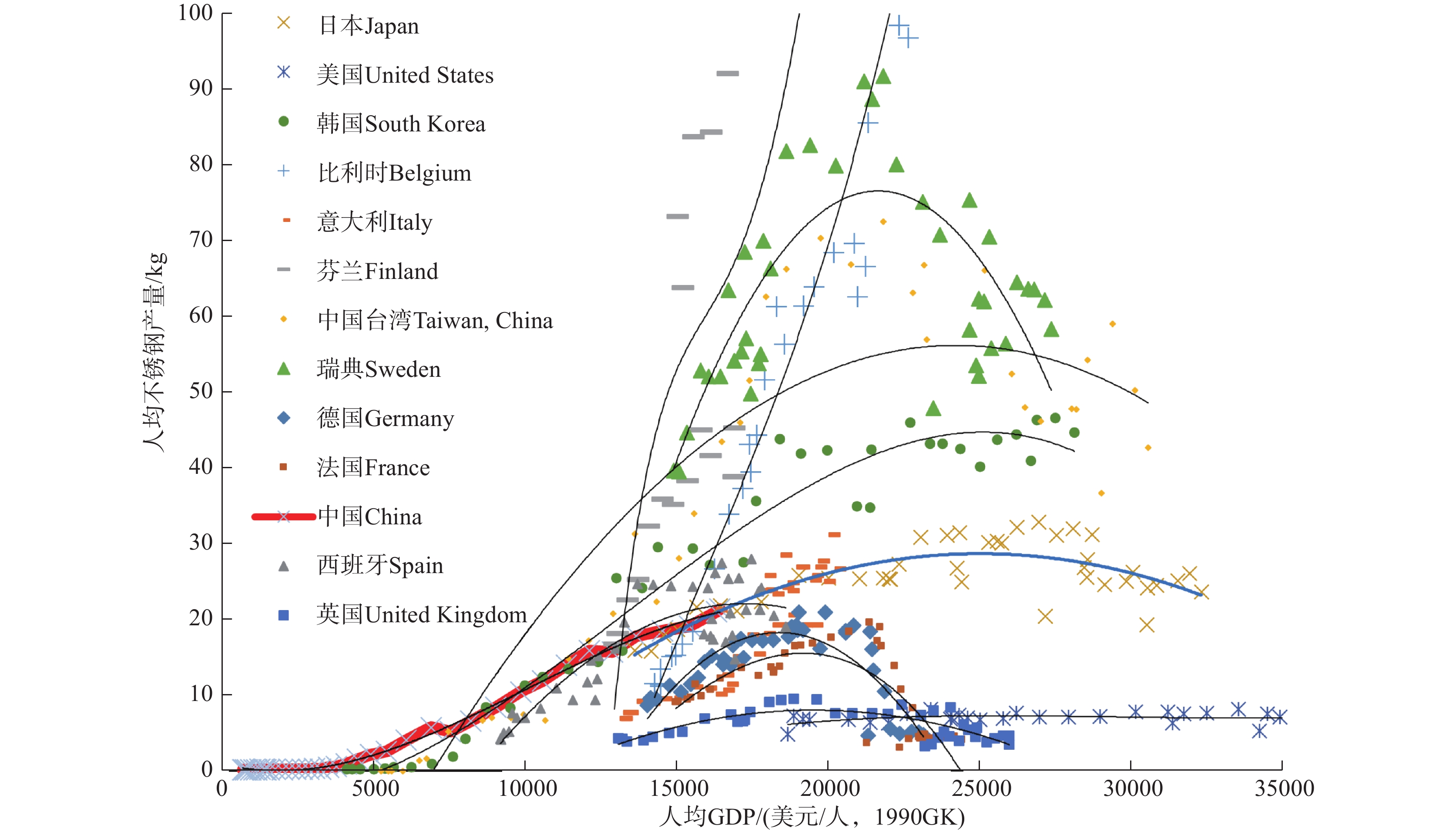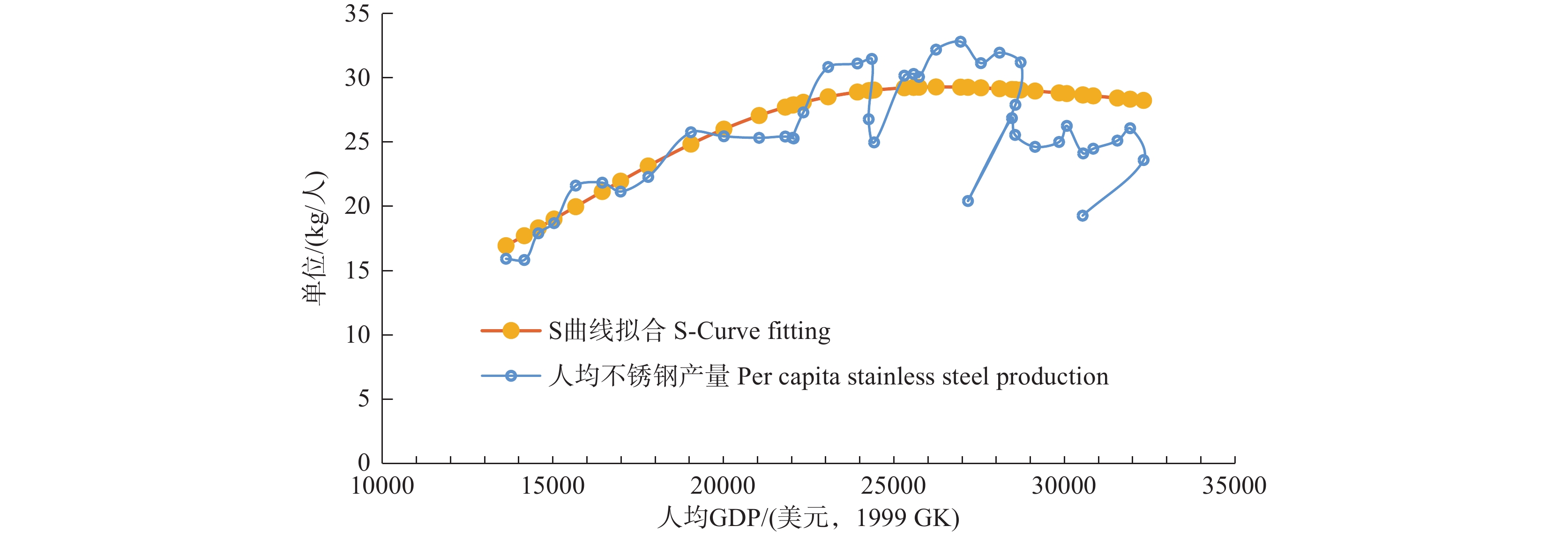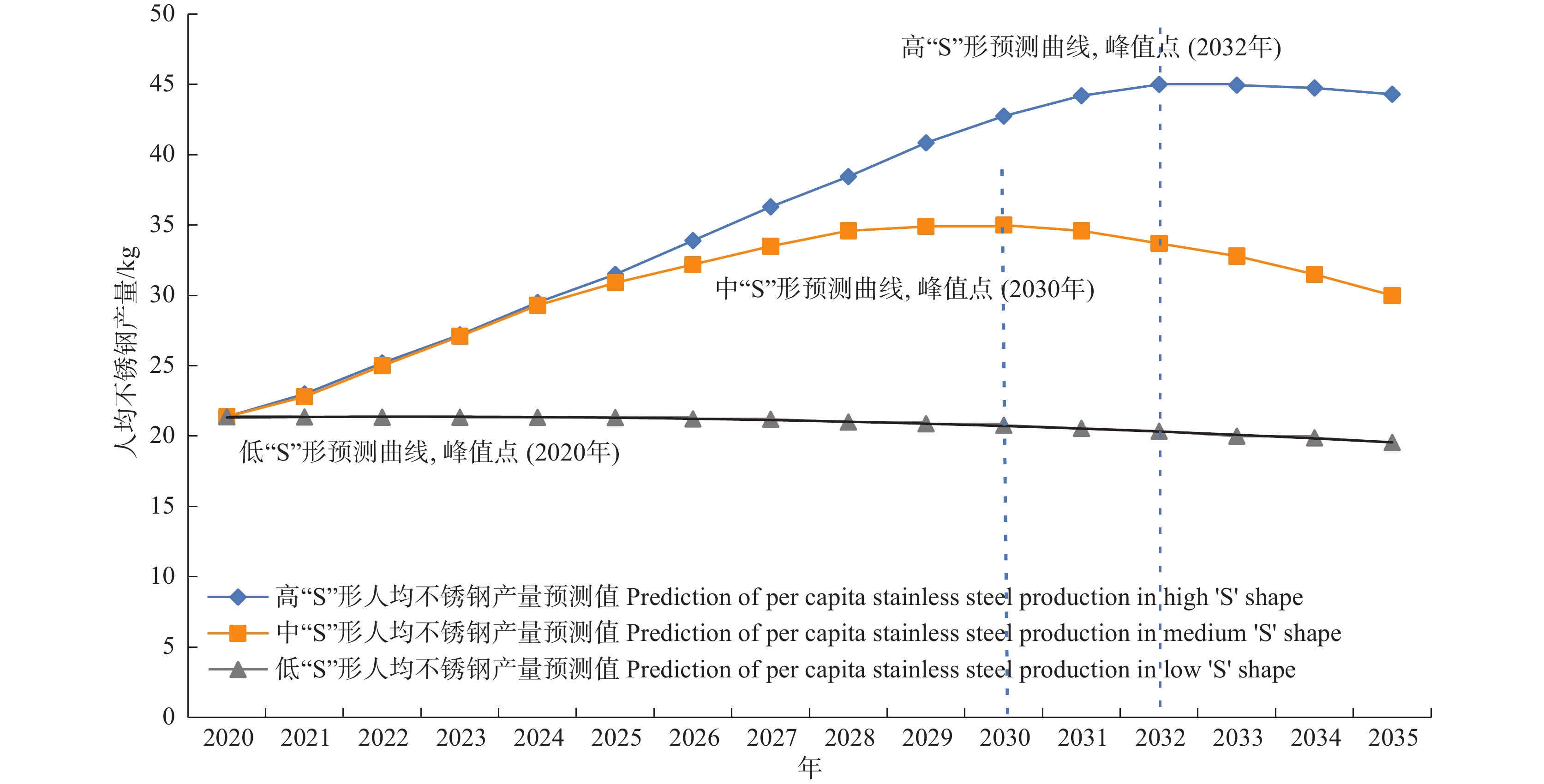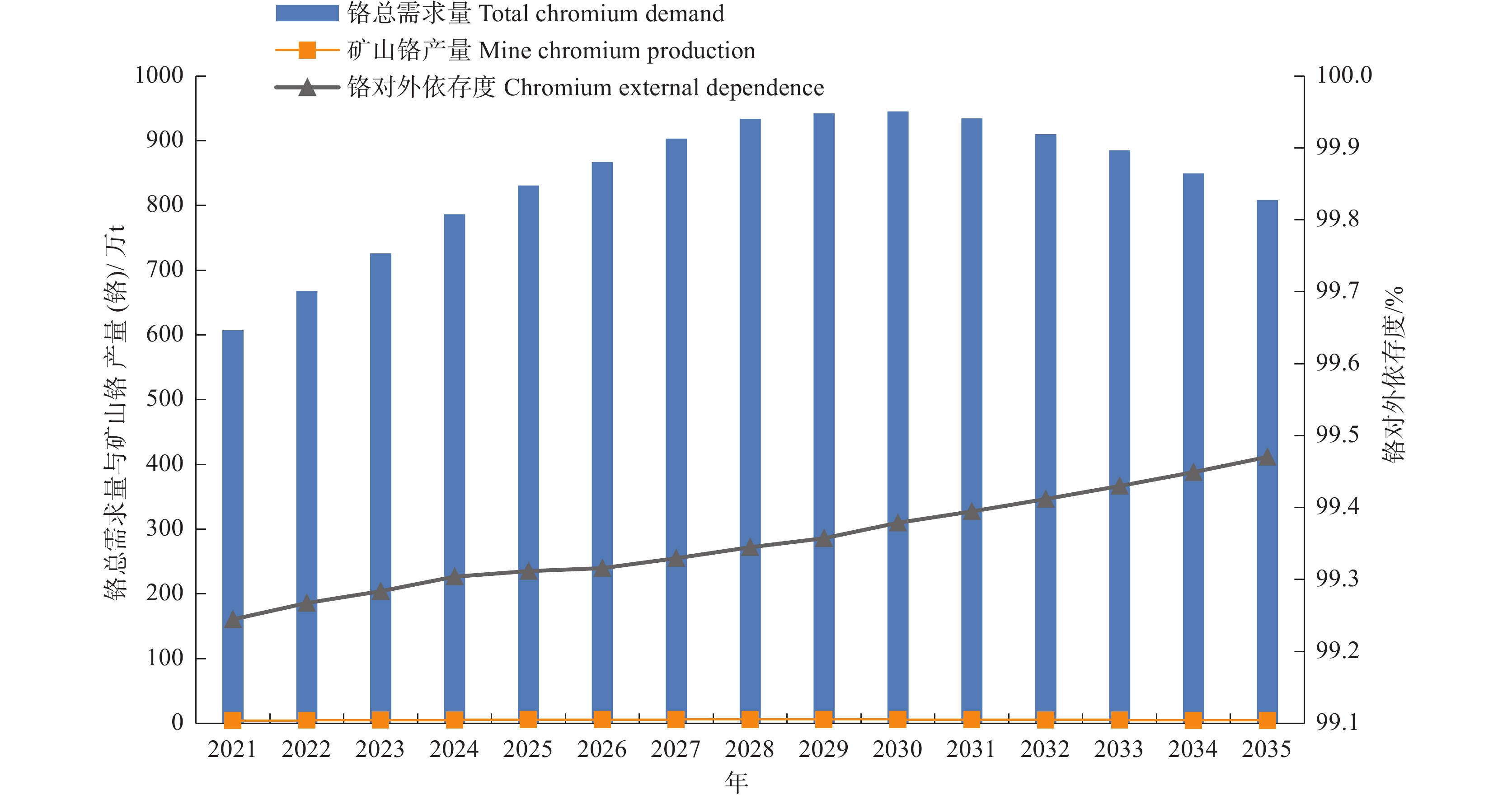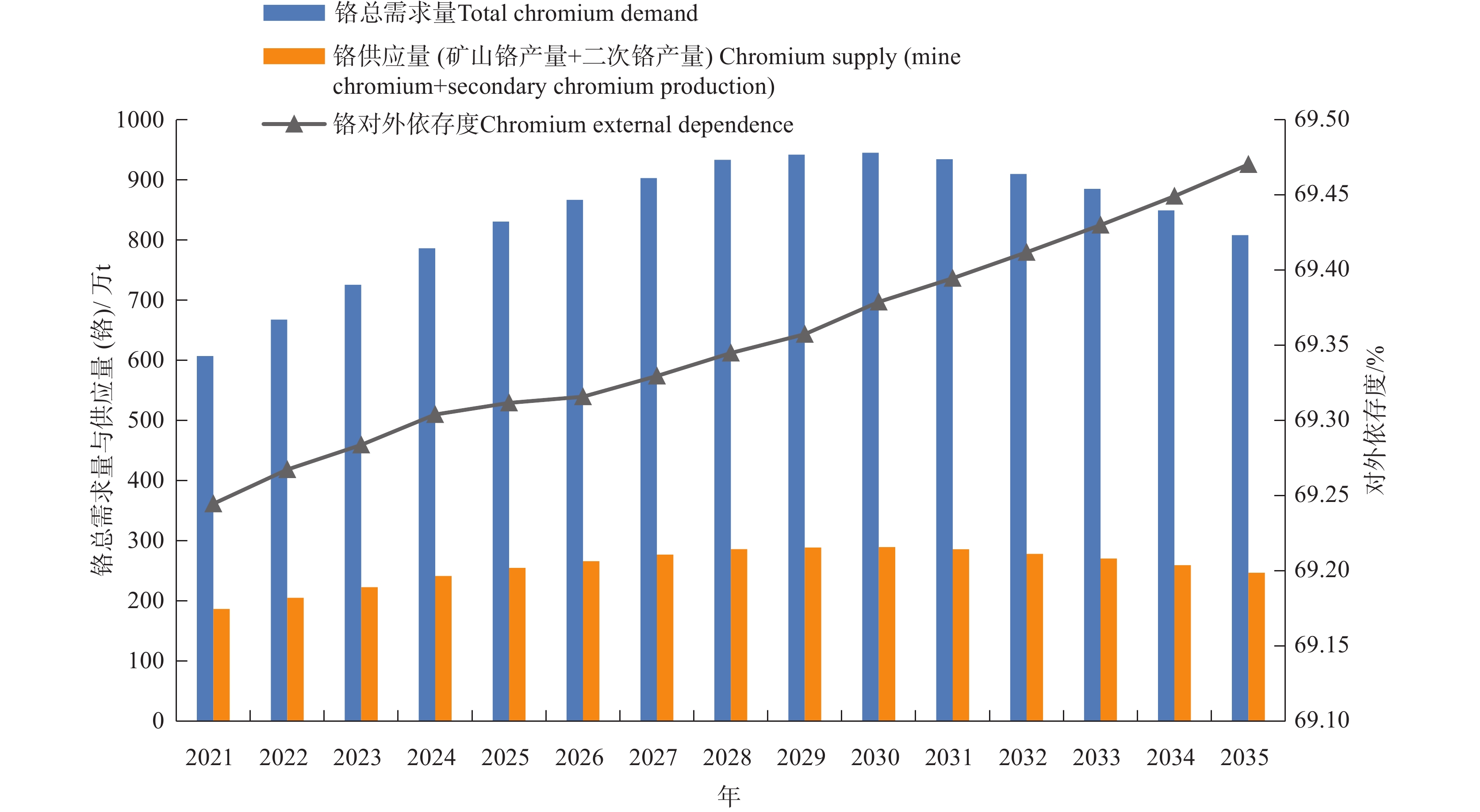Chromite ore resources characteristic and analysis of supply and demand situation from 2021 to 2035 in China
-
摘要:研究目的
铬矿作为我国关键性矿产之一,是支撑我国战略性新兴新兴产业发展的重要矿种。我国铬矿资源匮乏,资源禀赋不佳,产量低,长期以来,铬矿石对外依存度高。研究铬矿未来供需情况,对于铬矿资源产业良性持续发展至关重要。
研究方法本文对我国铬矿床地质、空间分布和资源储量等特征进行了总结,分析了我国铬矿资源开发利用的历史数据。在此基础上预测了我国铬供应量,并进一步利用铬部门消费法、人均不锈钢产量“S”形法、ARIMA模型法(不锈钢)等预测方法,分高、中、低3种情景对我国2021—2035年不锈钢产量和铬需求量进行了预测。
研究结果(1)2021—2035年我国矿山铬年预测产量(矿石量)为15~20万t,二次铬预测产量(铬金属量)在182~284万t内;(2)在中情景下,2021—2035年我国铬需求量呈现先增后降的趋势,峰值点为2030年。2021—2030年我国人均不锈钢产量呈上升趋势,2030年到达峰值点,届时人均不锈钢产量35 kg,不锈钢产量5005万t,折铬总需求量945.39万t;之后逐渐下降,到2035年人均不锈钢产量降至30 kg,不锈钢产量4280万t,铬总需求量808.44万t。(3)2021—2035年,我国铬供需形势严峻,矿山铬对外依存度99%以上,若利用二次铬产量,则铬对外依存度降至69%以上。
结论2021—2035年我国铬供需形势仍将严峻,缺口仍需大量进口矿石来补充。据此,提出加强铬矿地质勘查工作力度、力争实现铬矿找矿突破,重视二次铬回收利用、发展二次铬回收产业,加强铬矿产品储备、保障铬矿产品供应安全,优化铬矿产品结构,利用境外铬矿资源产品等对策结论。本文所形成的认识结论、对策建议对我国编制矿产资源规划、制定铬矿资源管理政策等具有一定的现实意义。
创新点:(1)系统分析了不同情景下2021—2035年我国铬供需趋势;(2)综合了部门消费法、人均不锈钢产量“S”形法、ARIMA模型(不锈钢)等多方法优点,提高了预测的精度。
Abstract:This paper is the result of mineral exploration engineering.
ObjectiveChromium, as one of the critical minerals in China, supports the development of China's emerging industries. China is short of chromium ore resources, poor resource endowment and low production. For a long time, the chrome ore has been highly dependent on foreign countries. It is important for the healthy and sustainable development of chromium ore resource industry to study the future supply and demand of chrome ore.
MethodsThis paper summarizes the geology, spatial distribution, resource reserves and other characteristics of chromium deposits in China, and analyzes the historical data of the development and utilization of chromium resources in China. On this basis, the chromium supply in China is analyzed and predicted. And the stainless steel production and chromium demand in 2021−2035 in China are predicted under three scenarios, namely high, medium and low, by using chromium sector consumption method, S−curve of per capita stainless steel production, ARIMA model method (stainless steel) and other prediction methods.
Results(1) The production of chromium in China will be 150,000−200,000 tons, and the secondary chromium will be 1.82−2.84 million tons from 2021 to 2035; (2) Under the medium scenario, the demand for chromium in China from 2021 to 2035 is projected to follow an increasing and then decreasing trend, with the peak occurring in 2030. And, the per capita stainless steel production will keep an upward trend from 2021 to 2030, and will reach its peak in 2030. At that time, the per capita stainless steel production will be 35 kg, the stainless steel production will be 50.05 million tons, and the chromium demand will be 9.45 million production; After that, it will gradually decline. By 2035, the per capita stainless steel production will drop to 30 kg, the stainless steel production will be 42.8 million tons, and the chromium demand will be 8.07 million tons; (3) The supply and demand situation is severe in China from 2021 to 2035, and the external dependence rate of chromium will exceed 99%. If secondary chromium production is used, the external dependence rate of chromium will drop to more than 69%.
ConclusionsThe supply and demand situation of chromium in China will still be severe, and the gap still needs to be supplemented by a large number of imported ores from 2021−2035. On this basis, it is proposed to strengthen the geological exploration of chromium ore, strive to achieve a breakthrough in chromium ore prospecting, attach importance to the secondary chromium recovery, develop the secondary chromium recovery industry, strengthen the reserves of chromium ore products, ensure the safety of chromium ore product supply, optimize the structure of chromium ore products, and make use of overseas chromium ore resources and products. The conclusions and suggestions formed in this paper are of practical significance to the compilation of mineral resources planning and the formulation of chromium mineral resources management policies in China.
Highlights:(1) The supply and demand trends of chromium ore in China from 2021 to 2035 under different scenarios are systematically analyzed and discussed; (2) The advantages of multiple methods such as sectoral consumption method, the S-curve of per capita stainless steel production, and ARIMA modularity were combined to improve the prediction accuracy.
-
1. 研究目的(Objective)
湘中坳陷作为南方复杂构造区页岩气勘探的热点地区之一,也是中国油气勘探久攻未克的地区。前期在湘中地区北部的涟源凹陷泥盆系和石炭系获得了页岩气突破和发现,证实了湘中地区上古生界页岩气资源丰富。但对湘中地区南部的邵阳凹陷调查程度较为薄弱,针对邵阳凹陷二叠系仅开展了少量基础地质调查工作,页岩气资源潜力评价方面的工作尤为欠缺。本次研究依托邵阳湘邵地1井(XSD1井)钻探工程建立了邵阳凹陷二叠系地层层序序列,揭示了主要含气页岩层系的分布特征,获取了含气性评价参数,对湘中地区二叠系页岩气勘探开发和重新评价湘中坳陷页岩气资源潜力具有重要的现实意义。
2. 研究方法(Methods)
中国地质调查局武汉地质调查中心在收集分析区域地质相关资料的基础上,结合邵阳凹陷短陂桥向斜的煤田浅钻、非震物探等资料开展页岩气地质综合评价,采用页岩埋深500~4500 m,页岩有机碳含量≥1.0%,页岩厚度≥15 m,页岩有机质热演化程度1.0%~3.5%的评价参数在短陂桥向斜区优选页岩气远景区,论证部署了1口小口径页岩气地质调查井—XSD1井,湖南煤田地质勘查有限公司组织实施钻探(图 1a)。该井采样全井段取心钻井工艺,测井选取PSJ-2数字测井系统,录井采用SK-2000G气测录井,钻获二叠系大隆组156.05 m(暗色硅质页岩、钙质泥岩94.48 m),龙潭组349.95 m(暗色泥岩216.93 m,粉砂质泥岩36.9 m),对这两套层系共采集暗色泥岩样品33件,进行解析气含量测定分析,落实了含气性评价参数。
3. 结果(Results)
本次样品分析工作由武汉地质调查中心古生物与生命-环境协同演化重点实验室完成,采用YSQ-IIIA岩石解析气测定仪(燃烧法)对含气段岩心共计33件样品进行分析。该井钻获二叠系大隆组厚度156.05 m,为一套硅质岩、硅质页岩、炭质钙质泥岩地层。其中在井深842~930.2 m硅质页岩、钙质泥岩段,气测全烃值从1.06%上升至16.54%,甲烷值从1.01%上升至14.04%,13件大隆组硅质页岩现场解析总含气量为1.29~9.97 m3/t,平均4.85 m3/t。实现了湘中坳陷二叠系页岩气新发现,有效拓展了华南地区大隆组勘探范围。
钻获龙潭组厚度349.95 m,上段为一套细砂岩、粉砂岩夹泥岩潮坪相沉积地层,下段为一套炭质泥岩、粉砂质泥岩夹薄层细砂岩泻湖相沉积地层。在井深1013.4~1048 m泥岩与粉砂岩互层段气测全烃值最高可达19.87%,甲烷值最高为16.94%,7件泥岩与粉砂岩样品现场解析总含气量0.57~3.42 m3/t,平均1.78 m3/t;井深1088.10~1199.75 m泥岩夹泥质粉砂岩含气层111.6 m,气测全烃值最高可达28.2%,甲烷值最高为23.6%,13件泥岩、粉砂质泥岩样品现场解析总含气量0.90~4.55 m3/t,平均2.01 m3/t(图 1b),首次查明了湘中坳陷二叠系龙潭组非常规油气分布特点。
通过区域地质背景分析,并结合煤田区域地质资料,本研究认为滑脱断裂(F9)上下盘具有不同的页岩气聚集条件。滑脱断裂之上由一系列的同向逆断层形成的逆冲推覆体,地层变形强烈,且裂缝发育,导致页岩气保存条件变差。滑脱断裂下盘是页岩气主要富集区,地层平缓,不发育次级通天断裂,与下盘地层形成反向遮挡,易形成封闭,保存条件良好(图 1c)。
4. 结论(Conclusions)
(1)二叠系大隆组岩性以硅质岩、硅质页岩为主,夹少量灰岩。主要含气段存在于上段硅质页岩段,厚88.2 m,含气量平均为4.85 m3/t,含气性优越,资源潜力大。
(2)二叠系龙潭组上段以致密砂岩气为主,含气量平均为1.78 m3/t;下段以页岩气为主,泥岩厚达177.47 m,含气量平均为2.01 m3/t,具有泥岩厚度大,含气性好等特征。
(3)保存条件是页岩气富集关键,构造改造弱的封闭演化环境有利于页岩气保存,研究区滑脱断裂下盘是页岩气主要富集区,易形成封闭,保存条件良好。
(4)湘邵地1井在二叠系大隆组和龙潭组获得良好的页岩气显示,证实了湘中地区二叠系具有良好的页岩气资源潜力,对湘中地区页岩气资源潜力评价具有重要意义。
5. 基金项目(Fund support)
本文为中国地质调查局项目“中扬子地区油气页岩气调查评价”(DD20221659)资助的成果。
-
图 2 1958—2020年我国矿山铬矿石(铬)产量及其在世界的比例(数据来源,USGS, 1996—2022,https://www.usgs.gov/centers/national-minerals-information-center/chromium-statistics-and-information;《中国铬矿志》编辑委员会,1996;朱训,1999 )
Figure 2. Mine production of chromium ore in China and proportion in the world from 1958 to 2020 (Data source: USGS, 1996−2022, https://www.usgs.gov/centers/national-minerals-information-center/chromium-statistics-and-information; Editorial Committee, Chronicles of Chromium Mines in China,1996; Zhu Xun, 1999)
图 3 2021—2035年我国铬矿石(铬)产量预测(数据来源:USGS,2000—2020,https://www.usgs.gov/centers/national-minerals-information-center/chromium-statistics-and-information调研数据)
Figure 3. Prediction of chromium ore (chromium) production in China from 2021 to 2035 (Data source: USGS, 2000−2020, https://www.usgs.gov/centers/national-minerals-information-center/chromium-statistics-and-information, mine survey)
图 4 1962—2020年美国二次铬产量占铬表观消费量的比例与人均GDP(基础数据来源:二次铬USGS,https://www.usgs.gov/centers/national-minerals-information-center/chromium-statistics-and-information,人均GDP 世界银行)
Figure 4. Proportion of secondary chromium production in apparent chromium consumption and per capita GDP in the United States from 1962 to 2020 (Data source : USGS, https://www.usgs.gov/centers/national-minerals-information-center/chromium-statistics-and-information, GDP per capita from the World Bank)
图 6 1952—2020年我国二次铬、铬表观消费量和不锈钢产量变化(不锈钢产量数据来源:World Bureau of Metal Statistics,1979—2021,https://world-bureau.co.uk/publications-services/metals-database/)
Figure 6. Secondary chromium, chromium apparent consumption and stainless steel production in China from 1952 to 2020 (Data source: World Bureau of Metal Statistics from 1979 to 2021, https://world-bureau.co.uk/publications-services/metals-database/)
图 8 世界主要国家或地区不同发展阶段人均GDP与人均不锈钢产量“S”形曲线图(红色粗线为中国未来人均不锈钢产量演进趋势线,其他线条为不同国家人均不锈钢产量演进的趋势线)
Figure 8. S−shaped curve between GDP per capita and stainless steel production of the main countries and regions in their different stages of development in the world (The red bold line represents the evolution trend of per capita stainless steel production in China in the future, while the other lines represent the trend lines of per capita stainless steel production evolution in different countries)
图 9 典型国家或地区不锈钢产量强度和人均GDP的关系图(倒“U”形曲线)(红色粗线为中国未来不锈钢产量强度演进趋势线,其他线条为不同国家不锈钢产量强度演进的趋势线)
Figure 9. Relationships between GDP per captia and stainless steel production intensity of the typical countries or regions (Inverted U−shaped curves) (The red bold line represents the trend line in the evolution of stainless steel production intensity in China in the future, while the other lines represent the trend lines of stainless steel production intensity evolution in different countries)
表 1 2021年世界铬铁矿分布
Table 1 Distribution of chromium reserves in the world in 2021
国家 储量*/万t 储量分布/% 南非 20000 35.1% 哈萨克斯坦 23000 40.4% 印度 10000 17.5% 芬兰 2600 4.6% 土耳其 1300 2.3% 世界总量 57000 100.0% 注:*储量为商品级铬矿石量(保有量);除美国铬矿石品位Cr2O3归一化为7%、芬兰铬矿石品位Cr2O3归一化为26%,其他国家的铬矿石品位Cr2O3一律归一化为45%;数据来源:USGS,Mineral Commodity Summaries, January 2022, Chromium。 表 2 三种“S”形情景下典型国家和地区人均不锈钢产量、人均GDP及人均铬需求量
Table 2 Per capita stainless steel production, per capita GDP and per capita chromium demand in typical countries and regions under three scenarios
情 景 参考国家或地区 峰值点/年 人均GDP/
(万美元/人,1990 GK 美元)*人均不锈钢产量/kg 人均铬需求量/kg 高情景(高“S”形) 瑞典
中国台湾
韩国2001
2007
20152.12~2.18
2.1~2.3
2.56~2.7575~78
55~58
43~4612.75~13.26
9.35~9.86
7.31~7.82中情景(中“S”形) 日本 2000 2.44~2.56 29~33 4.93~5.61 低情景(低“S”形) 德国
法国
英国2001
1994
19941.8~1.9
1.86~1.89
1.81~1.8819~21
15~17
8~93.23~3.57
2.55~2.89
1.36~1.53注:*1999盖凯美元,以1990年美元为标准,将各国GDP折算成统一化的货币标准——盖凯美元,便于对比研究分析。 表 3 中国不锈钢产量ARIMA模型法拟合统计量
Table 3 ARIMA model statistics of stainless steel production in China
模型 预测变量数 模型拟合统计量 平稳的 R2 R2 RMSE MAPE MAE MaxAPE MaxAE 正态化的BIC ssconsumption-模型_1 1 0.340 0.995 49.232 36.895 28.946 85.180 214.552 8.107 注:RMSE、MAPE、MAE和BIC分别表示均方根误差、平均绝对百分比误差、平均绝对误差和贝叶斯信息准则。 表 4 2021—2035年中国不锈钢产量预测结果(不锈钢产量/万t)
Table 4 Prediction results of stainless steel production in China from 2021 to 2035 (stainless steel production)
年份 拟合值(不锈钢产量) 置信下限** 置信上限** 2021 3126.06 3027.87 3224.25 2022 3383.07 3231.93 3534.2 2023 3646.11 3453.44 3838.78 2024 3919.96 3692.11 4147.81 2025 4205.72 3946.68 4464.75 2026 4503.78 4216.31 4791.26 2027 4814.44 4500.54 5128.33 2028 5137.92 4799.17 5476.67 2029 5474.49 5112.14 5836.84 2030 5824.38 5439.47 6209.3 2031 6187.84 5781.23 6594.45 2032 6565.11 6137.56 6992.65 2033 6956.43 6508.6 7404.26 2034 7362.05 6894.52 7829.58 2035 7782.21 7295.49 8268.93 注:**95%的置信水平。 表 5 2021—2035年中国不锈钢产量预测结果
Table 5 Prediction results of stainless steel production in China from 2021 to 2035
情景 年份 人均不锈钢产量“S”形法 ARIMA(2,2,1)模型法(不锈钢) 不锈钢综合预测结果 人均产量/
(kg/人)产量/
万t人均产量/
(kg/人)产量/万t
(拟合值)人均产量/
(kg/人)产量/
万t高情景方案
(参考高“S”形预测)2020 21.38 3004.79 21.38 3004.79 21.38 3004.79 2021 23.00 3244 25.06 3534.2 22.58 3185 2022 25.20 3564 27.14 3838.78 24.56 3474 2023 27.20 3857 29.25 4147.81 26.46 3751 2024 29.50 4192 31.42 4464.75 28.54 4056 2025 31.50 4484 33.65 4791.26 30.52 4345 2026 33.90 4833 35.97 5128.33 32.74 4669 2027 36.30 5181 38.37 5476.67 35.01 4998 2028 38.45 5493 40.85 5836.84 37.21 5316 2029 40.85 5839 43.44 6209.3 39.57 5657 2030 42.75 6113 46.12 6594.45 41.74 5969 2031 44.20 6320 48.90 6992.65 43.74 6254 2032(1) 45.00 6434 51.79 7404.26 45.46 6499 2033 44.95 6424 54.79 7829.58 44.95 6424 2034 44.75 6391 57.90 8268.93 44.75 6391 2035 44.30 6320 24.77 3534.2 44.30 6320 中情景方案
(参考中“S”形预测,利用了日本
人均不锈钢预测函数)2020 21.38 3004.79 21.38 3004.79 21.38 3004.79 2021 22.80 3215 22.17 3126.06 22.80 3215 2022 25.00 3536 23.92 3383.07 25.00 3536 2023 27.10 3843 25.71 3646.11 27.10 3843 2024 29.30 4164 27.59 3919.96 29.30 4164 2025 30.90 4399 29.54 4205.72 30.90 4399 2026 32.20 4591 31.59 4503.78 32.20 4591 2027 33.50 4782 33.73 4814.44 33.50 4782 2028 34.60 4943 35.96 5137.92 34.60 4943 2029 34.90 4989 38.30 5474.49 34.90 4989 2030(2) 35.00 5005 40.73 5824.38 35.00 5005 2031 34.60 4948 43.27 6187.84 34.60 4948 2032 33.70 4818 45.92 6565.11 33.70 4818 2033 32.80 4687 48.68 6956.43 32.80 4687 2034 31.50 4498 51.55 7362.05 31.50 4498 2035 30.00 4280 54.55 7782.21 30.00 4280 低情景方案
(参考低“S”形预测)2020(3) 21.38 3004.79 21.38 3004.79 21.38 3004.79 2021 21.36 3012 22.92 3231.93 21.36 3012 2022 21.35 3020 24.42 3453.44 21.35 3020 2023 21.34 3026 26.03 3692.11 21.34 3026 2024 21.33 3031 27.78 3946.68 21.33 3031 2025 21.32 3035 29.61 4216.31 21.32 3035 2026 21.22 3025 31.57 4500.54 21.22 3025 2027 21.20 3026 33.62 4799.17 21.20 3026 2028 21.00 3000 35.78 5112.14 21.00 3000 2029 20.88 2985 38.05 5439.47 20.88 2985 2030 20.77 2970 40.43 5781.23 20.77 2970 2031 20.55 2939 42.92 6137.56 20.55 2939 2032 20.35 2909 45.52 6508.6 20.35 2909 2033 20.00 2858 48.25 6894.52 20.00 2858 2034 19.88 2839 51.08 7295.49 19.88 2839 2035 19.55 2789 22.65 3231.93 19.55 2789 注:(1)高情景方案下的峰值点。(2)中情景方案下的峰值点。(3)低情景方案下的峰值点。2020年各指标为实际值。 表 6 2021—2035年中国铬矿供需形势综合分析表
Table 6 Comprehensive analysis of supply and demand situation of chromium ore in China from 2021 to 2035
项目(中情景) 铬预测结果 2021年 2025年 2030年 2035年 铬需求侧 不锈钢需求量(万t) 3215 4399 5005 4280 折铬需求量(万t)∗ 546.55 747.83 850.85 727.60 铬总需求量(万t)∗∗ 607.28 830.92 945.39 807.33 累计铬需求量(万t) 607.28 19157
(2021—2025)43467
(2021—2030)66698
(2021—2035)铬供给侧 矿山铬产量(铬 万t) 4.59 5.72 5.87 4.28 累计矿山铬产量(铬 万t) 4.59 25.87
(2021—2025)55.90
(2021—2030)80.92
(2021—2035)二次铬产量(万t)∗∗∗ 182.18 249.27 283.62 242.20 累计二次铬产量(万t) 182.18 1085.86
(2021—2025)2463.13
(2021—2030)3779.55
(2021—2035)综合 对外依存度(%)(不含二次铬产量) 99.24 99.31 99.38 99.47 对外依存度(%)(含二次铬产量) 69.24 69.31 69.38 69.47 供需缺口(不含二次铬产量) 602.69 825.20 939.52 804.16 供需缺口(含二次产量) 420.51 575.93 655.90 561.63 铬对需求的保障率(%)(不含二次铬产量) 0.76 0.69 0.62 0.53 铬对需求的保障率(%)(含二次铬产量) 30.76 30.69 30.62 30.53 注:∗不锈钢中的含铬量按17%测算;∗∗按铬在不锈钢中消费量占比90%测算;∗∗∗按二次铬产量占铬表观消费量比例的30%测算。需求的保障率=(国内供应量/总需求量)×100%,对外依存度=(1−国内供应量/总需求量)×100%。 -
[1] Bao Peisheng, Wang Xibin, Peng Genyong, Chen Fangyuan. 1999. Chromium Iron Deposits in China[M]. Beijing: Science Press (in Chinese with English abstract).
[2] Chen Qishen, Wang Gaoshang, Wang Anjian. 2010. An analysis of the three turning points in the “S−shape” rule of copper and aluminum demand[J]. Acta Geoscientica Sinica, 31(5): 659−665 (in Chinese with English abstract).
[3] Department of Mineral Resources Protection And Supervision, Ministry of Natural Resources, Mineral Resources Reserve Evaluation Center, Ministry of Natural Resources. 2021. Compilation of Technical Standards for Mineral Resources Reserves[M]. Beijing: Geological Publishing House, 1232−1233 (in Chinese).
[4] Editorial Committee, Chronicles of Chromium Mines in China. 1996. Chronicles of Chromium Mines in China [M]. Beijing: Metallurgical Industry Press (in Chinese).
[5] Editorial Committee, Handbook of Industrial Requirements for Mineral Resources. 2010. Handbook of Industrial Requirements for Mineral Resources[M]. Beijing: Geological Publishing House (in Chinese).
[6] Gao Xinrui, Wang Anjian. 2010. The prediction of China’s steel demand based on S−shaped regularity[J]. Acta Geoscientica Sinica, 31(5): 645−652 (in Chinese with English abstract).
[7] Gao X R, Wang A J, Liu G W, Liu C H, Yan K. 2018. Expanded S−curve model of a relationship between crude steel consumption and economic development: Empiricism from case studies of developed economies[J]. Natural Resources Research, 28: 547−562.
[8] Ju Jianhua, Zhang Zhaozhi, Pan Zhaoshuai, Che Dong, Li Houmin. 2022. Determination of mineral resources in China’s strategic emerging industries and analysis of the demand of the “14th five−year plan”[J]. China Mining Magazine, 31(9): 1−11 (in Chinese with English abstract).
[9] Lu Ning. 2018. Prediction and analysis of stainless steel production in 2020 and 2025, China[J]. Metallurgical Economy and Management, (3): 43−48 (in Chinese with English abstract).
[10] Höök M, Li J C, Oba N, Snowden S. 2011. Descriptive and predictive growth curves in energy system analysis[J]. Natural Resources Research, 20: 103−116. doi: 10.1007/s11053-011-9139-z
[11] Huang Darong, Huang Lifen. 2009. Present situation and development tendency of grey system theory in fault forecast application[J]. Journal of Gun Launch & Control, (3): 88−92 (in Chinese with English abstract).
[12] Liu Xuan, Chen Qishen, Zhang Yanfei, Gao Tianming. 2015. Chinese chromium demand forecasting and resource supply security[J]. Resources Science, 37(5): 933−943 (in Chinese with English abstract).
[13] Ministry of Natural Resources. 2021a. Statistical Table of National Mineral Resources Reserves [EB/OL]. http://www.mnr.gov.cn/(in Chinese).
[14] Ministry of Natural Resources. 2021b. China Mineral Resources (2020) [M]. Beijing: Geological Publishing House (in Chinese).
[15] Michael A K. 2022. Product innovation, diffusion and endogenous growth[J]. Review of Economic Dynamics, 48: 178−201.
[16] Wang A J, Wang G S, Chen Q S, Yu W J, Yan K, Yang H B. 2015. S−curve model of relationship between energy consumption and economic development[J]. Natural Resources Research, 24(1): 53−64. doi: 10.1007/s11053-014-9234-z
[17] Wang Anjian, Wang Gaoshang. 2002. Mineral Resources and National Economic Development [M]. Beijing: Seismological Press (in Chinese with English abstract).
[18] Wang Anjian, Wang Gaoshang, Chen Qishen, Yu Wenjia, Yan Qiang, Han Shuqin, Zhang Zhaozhi, Niu Jianying, Zhou Fengying, Geng Nuo, Wang Lili, Liu Sha, Na Danni. 2008. Energy and National Economic Development [M]. Beijing: Geological Publishing House (in Chinese with English abstract).
[19] Wang Denghong, Zhang Shaohua, Xiong Xianxiao. 2018. Geological Records of Mineral Resources in China[M]. Beijing: Geological Publishing House (in Chinese with English abstract).
[20] Wei Weiqiang. 2006. The reason of Japan’s development and stagnate in economy and its inspiration to that of China[J]. Aroud Southeast Asia, (11): 69−74 (in Chinese with English abstract).
[21] Zhang Wei. 2016. Demand analysis and prediction of world chrome resource[J]. Resources & Industries, 18(4): 87−91 (in Chinese with English abstract).
[22] Zhang Zenan, Zhang Zhaozhi, Pan Zhaoshuai, Wu Qing, Xu Hengyi. 2019. Analysis of China’ supply safety by global chromium ore resources countries[J]. Chinese Mining Magazine, 28(10): 69−76 (in Chinese with English abstract).
[23] Zheng Minggui, Yuan Xuemei. 2018. Demand forecasting of China’s chrome ore from 2020 to 2030 based on grey neural network[J]. Resources Development & Metal, 34(6): 747−752 (in Chinese with English abstract).
[24] Zhu Mingyu, Wang Chenghui, Wang Denghong, Li Lixing, Zhang Jian, Wang Guorui, Zhou Xiang. 2013. The major Chromiun concentration areas in China and a discussion on their resource potential[J]. Geology in China, 40(4): 995−1006 (in Chinese with English abstract).
[25] Zhu Xun. 1999. China Mining Situation (Volume 2 Metal Minerals) [M]. Beijing: Science Press, 1−665 (in Chinese).
[26] 鲍佩声, 王希斌, 彭根永, 陈方远. 1999. 中国铬铁矿床[M]. 北京: 科学出版社. [27] 陈其慎, 王高尚, 王安建. 2010. 铜、铝需求“S”形规律的三个转变点剖析[J]. 地球学报, 31(5): 659−665. [28] 高芯蕊, 王安建. 2010. 基于“S”规律的中国钢需求预测[J]. 地球学报, 31(5): 645−652. [29] 国家统计局. 2018. 战略性新兴产业分类(2018)[EB/OL]. [2021−11−05] http://www.stats.gov.cn/tjgz/tzgb/201811/t20181126_1635848.html [30] 《矿产资源工业要求手册》编委会. 2010. 矿产资源工业要求手册[M]. 北京: 地质出版社. [31] 鞠建华, 张照志, 潘昭帅, 车东, 李厚民. 2022. 我国战略性新产业矿产厘定与“十四五”需求分析[J]. 中国矿业, 31(9): 1−11. doi: 10.12075/j.issn.1004-4051.2022.09.025 [32] 鹿宁. 2018. 2020年和2025年我国不锈钢产量预测分析[J]. 冶金经济与管理, (3): 43−48. doi: 10.3969/j.issn.1002-1779.2018.03.013 [33] 黄大荣, 黄丽芬. 2009. 灰色系统理论在故障预测中的应用现状及其发展趋势[J]. 火炮发射与控制学报, (3): 88−92. doi: 10.3969/j.issn.1673-6524.2009.03.023 [34] 刘璇, 陈其慎, 张艳飞, 高天明. 2015. 中国铬需求预测及资源供应安全态势分析[J]. 资源科学, 37(5): 0933−0943. [35] 王安建, 王高尚. 2002. 矿产资源与国家经济发展[M]. 北京: 地震出版社. [36] 王安建, 王高尚, 陈其慎, 于汶加, 闫强, 韩淑琴, 张照志, 牛建英, 周凤英, 耿诺, 汪莉丽, 刘莎, 那丹妮. 2008. 能源与国家经济发展[M]. 北京: 地质出版社. [37] 王登红, 章少华, 熊先孝. 2018. 中国矿产地质志[M]. 北京: 地质出版社. [38] 韦伟强. 2006. 日本经济发展、停滞原因及对中国经济的启示[J]. 东南亚纵横, (11): 69−74. doi: 10.3969/j.issn.1003-2479.2006.11.014 [39] 张炜. 2016. 世界铬矿资源需求分析及预测[J]. 资源与产业, 18(4): 87−91. [40] 张泽南, 张照志, 潘昭帅, 吴晴, 徐恒逸. 2019. 全球铬矿石资源国对中国供应安全度分析[J]. 中国矿业, 28(10): 69−76. [41] 郑明贵, 袁雪梅. 2018. 基于灰色神经网络的中国2020−2030年铬矿需求预测[J]. 资源开发与市场, 34(6): 747−752 doi: 10.3969/j.issn.1005-8141.2018.06.002 [42] 朱明玉, 王成辉, 王登红, 李立兴, 张建, 王国瑞, 周详. 2013. 中国铬矿主要矿集区及其资源潜力探讨[J]. 中国地质, 40(4): 995−1006. doi: 10.3969/j.issn.1000-3657.2013.04.001 [43] 朱训. 1999. 中国矿情(第二卷 金属矿产)[M]. 北京: 科学出版社, 1−665. [44] 《中国铬矿志》编辑委员会. 1996. 中国铬矿志[M]. 北京: 冶金工业出版社. [45] 自然资源部. 2021a. 全国矿产资源储量统计表[EB/OL]. [2021−12−01] http://www.mnr.gov.cn/. [46] 自然资源部. 2021b. 中国矿产资源报告(2020)[M]. 北京: 地质出版社. [47] 自然资源部矿产资源保护监督司, 自然资源部矿产资源储量评审中心. 2021. 矿产资源储量技术标准汇编 [M]. 北京: 地质出版社, 1232−1233.




 下载:
下载:
